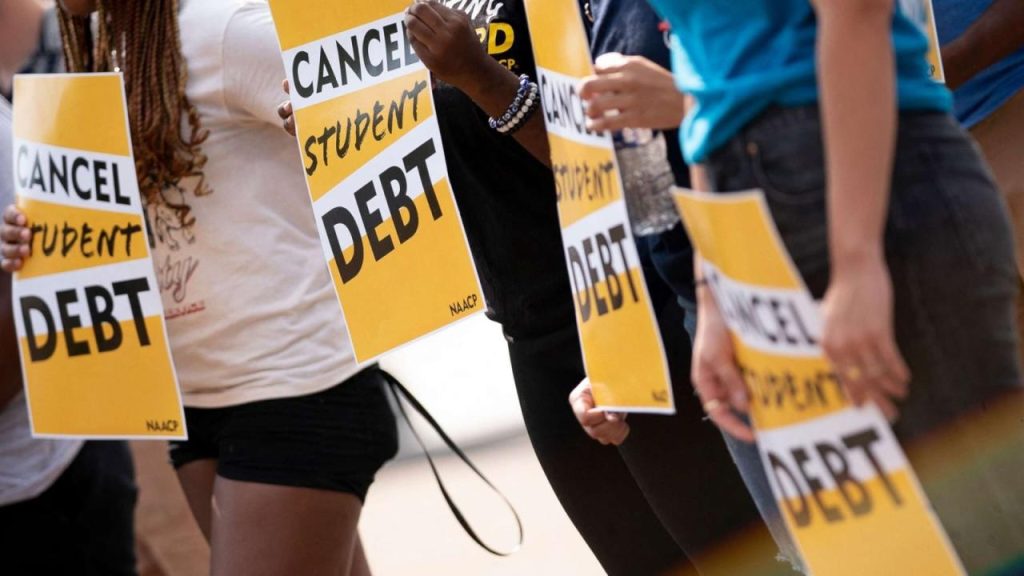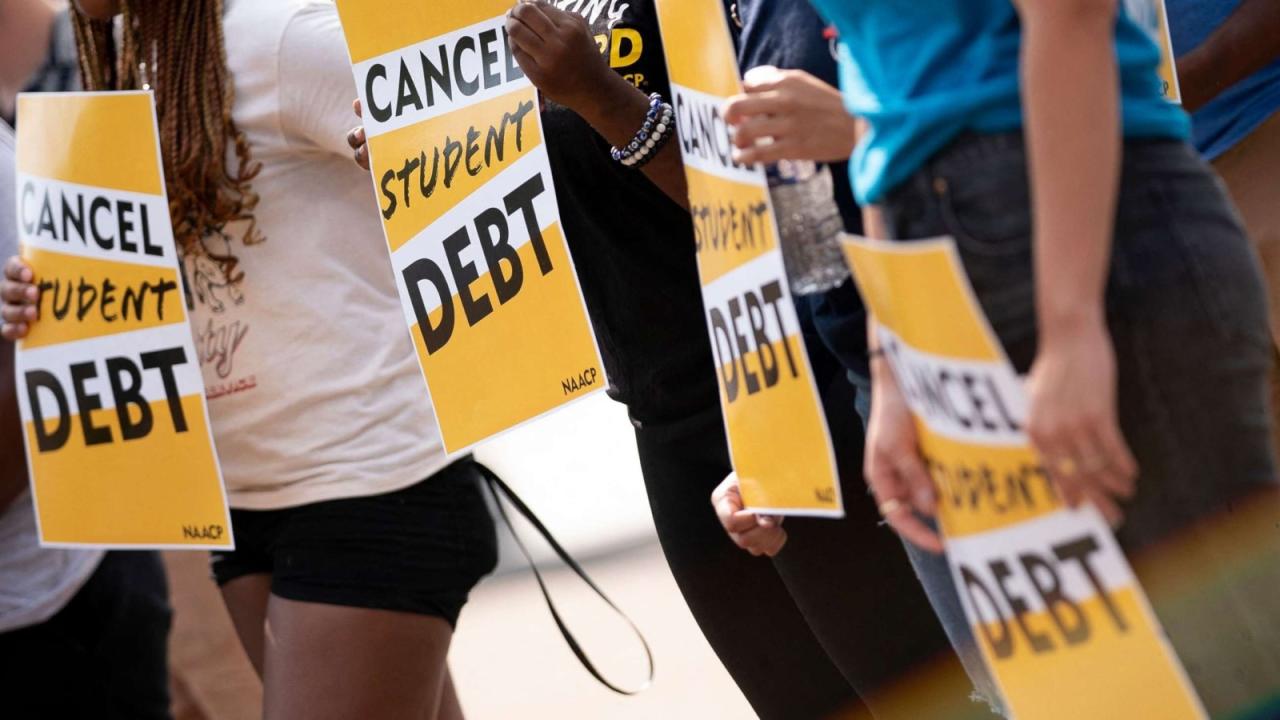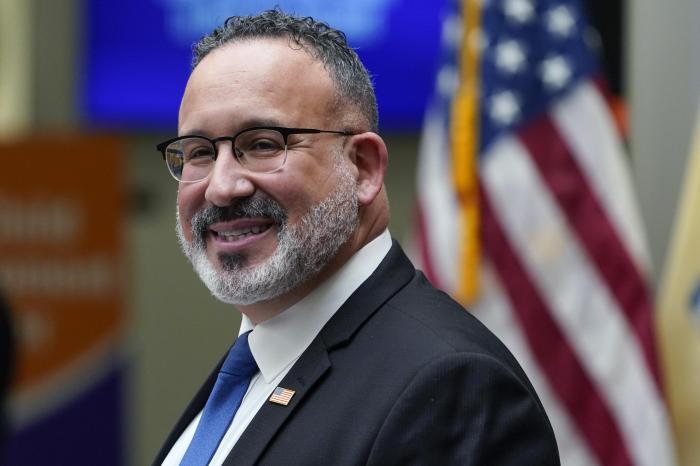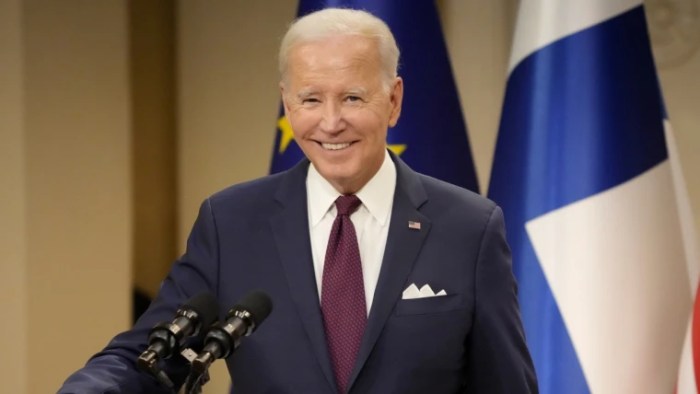
The White House’s influence on student loan policies significantly impacts millions of Americans. From loan forgiveness programs to repayment plans, Presidential administrations have shaped the landscape of student debt, leaving lasting effects on borrowers and the economy. This exploration delves into the history, impact, and future trajectory of White House involvement in student loan programs, examining both successes and shortcomings.
We will analyze the various approaches taken by different administrations, exploring the political dynamics involved and the public’s reaction to these policies. We’ll consider the role of Congress, the influence of media narratives, and the potential for future reforms to address the ongoing challenges of student debt.
White House Initiatives on Student Loans
The involvement of the White House in student loan programs has a long and complex history, reflecting evolving economic priorities and political ideologies. From initial programs designed to expand access to higher education to current debates surrounding debt forgiveness and repayment reform, the executive branch has played a pivotal role in shaping the landscape of student lending in the United States. This exploration examines the key initiatives, policies, and shifts in approach across different administrations.
History of White House Involvement in Student Loan Programs
Federal involvement in student loan programs began in the mid-20th century, initially focusing on providing loans to veterans returning from World War II. The National Defense Education Act of 1958 marked a significant expansion, providing federal funding for student loans to address concerns about a perceived shortage of scientists and engineers during the Cold War. Subsequent legislation, such as the Higher Education Act of 1965, further broadened access to federal student aid, laying the groundwork for the extensive system we see today. Over time, the programs evolved, incorporating various loan types, repayment options, and income-driven repayment plans.
Current White House Policies Regarding Student Loan Forgiveness and Repayment
The Biden administration has implemented several significant initiatives aimed at addressing the student loan debt crisis. These include extending the pause on federal student loan payments during the COVID-19 pandemic and announcing a plan for targeted student loan forgiveness. This plan, however, faced legal challenges and was ultimately blocked by the Supreme Court. The administration continues to explore alternative avenues for providing relief, including expanding access to income-driven repayment plans and simplifying the application process. Further initiatives focus on improving borrower communication and education regarding repayment options.
Comparison of Different White House Administrations’ Approaches to Student Loan Debt
Different presidential administrations have adopted varying approaches to student loan debt. The Obama administration, for example, expanded income-driven repayment plans and implemented programs aimed at helping borrowers struggling with repayment. The Trump administration, while not enacting large-scale forgiveness programs, focused on streamlining the application process for certain loan forgiveness programs and exploring alternative approaches to repayment. The Biden administration, as noted, has taken a more proactive approach to debt relief, though the extent of its success remains to be seen given the legal challenges faced.
Timeline of Significant White House Actions Related to Student Loans
| Year | Administration | Significant Action |
|---|---|---|
| 1958 | Eisenhower | National Defense Education Act |
| 1965 | Johnson | Higher Education Act |
| 2007 | Bush | Expansion of income-driven repayment |
| 2010 | Obama | Creation of Pay As You Earn (PAYE) plan |
| 2022 | Biden | Proposed student loan forgiveness plan (later blocked) |
Comparison of Key Features of Different Student Loan Repayment Plans
| Repayment Plan | Payment Calculation | Maximum Repayment Period | Eligibility Requirements |
|---|---|---|---|
| Standard Repayment | Fixed monthly payment over 10 years | 10 years | All federal student loans |
| Graduated Repayment | Payments start low and increase over time | 10 years | All federal student loans |
| Income-Driven Repayment (IDR) | Payment based on income and family size | 20-25 years | Specific federal student loans |
| Extended Repayment | Fixed monthly payments over a longer period | Up to 25 years | All federal student loans |
Impact of White House Policies on Student Loan Borrowers

Recent White House initiatives have significantly altered the landscape of student loan debt in the United States, impacting millions of borrowers. These policies, while aiming to alleviate the burden of student loan debt, have had varied effects, both positive and negative, depending on individual circumstances and demographics. Understanding these impacts requires a careful examination of specific policies and their consequences.
Effects of Recent Initiatives on Student Loan Debt Levels
The most impactful recent initiative has been the extended pause on federal student loan repayments, initially implemented in response to the COVID-19 pandemic. This pause, while providing temporary relief to borrowers, also contributed to the overall growth of the national student loan debt. While preventing immediate defaults, it did not address the underlying issue of affordability and accessibility of higher education. The subsequent forgiveness programs, such as the limited income-driven repayment (IDR) plan expansions, have aimed to reduce debt levels for specific borrowers, but their long-term effects on overall debt are still being assessed and require further data analysis to determine their complete impact. The administration’s efforts to simplify the application process for IDR plans have also had a positive impact on access to these debt relief programs. However, the overall impact on national debt levels remains complex and requires further study.
Examples of How Specific White House Policies Have Helped or Hindered Student Loan Borrowers
The expanded income-driven repayment (IDR) plans have helped borrowers with lower incomes by lowering their monthly payments and potentially shortening their repayment periods. However, the eligibility criteria for these plans can be complex and challenging to navigate, potentially hindering some borrowers from accessing the relief they need. Similarly, the forgiveness programs, while offering a significant reduction in debt for eligible borrowers, have faced criticism for their complex application processes and limited scope. For example, the Public Service Loan Forgiveness (PSLF) program, while intended to forgive loans for public servants after ten years of payments, has been plagued by administrative hurdles, resulting in a low forgiveness rate initially. Subsequent reforms have attempted to address these issues, improving accessibility and increasing forgiveness rates.
Economic Impact of White House Student Loan Policies on Different Demographics
Data suggests that White House student loan policies have disproportionately benefited certain demographics. Borrowers from lower socioeconomic backgrounds have generally benefited more from income-driven repayment plans and forgiveness programs, as these policies directly address their financial limitations. However, higher-income borrowers may see less benefit from these programs, leading to potential equity concerns. Furthermore, the racial disparities in student loan debt accumulation and access to higher education mean that minority borrowers may experience both the benefits and the limitations of these policies in a way that differs from the majority. A thorough analysis of this data, accounting for factors like income, race, and educational attainment, is needed to fully understand the policy’s impact on equity. Further research on this matter is ongoing.
Potential Long-Term Consequences of White House Actions on the Student Loan Market
The long-term consequences of these policies are multifaceted and uncertain. The significant expansion of IDR plans and forgiveness programs could potentially lead to increased borrowing in the future, as borrowers may perceive lower risks associated with higher education costs. This could, in turn, contribute to the further growth of the student loan debt market. Conversely, the simplification of application processes and increased transparency could lead to a more efficient and equitable system, ultimately benefiting borrowers and promoting responsible borrowing practices. The overall effect will depend on how these different forces interact over time.
Hypothetical Scenario: Impact of a Potential Future White House Policy
Let’s consider a hypothetical scenario: A future White House administration proposes a policy that forgives a significant portion of student loan debt for borrowers who pursue careers in specific high-demand fields, such as healthcare or STEM. This policy could incentivize students to pursue these fields, potentially addressing workforce shortages. However, it could also lead to increased competition in these fields and potentially exacerbate existing inequalities if access to these high-demand fields remains limited to certain demographics. This type of policy would need to be carefully designed to address both its potential benefits and its potential drawbacks, ensuring that it achieves its intended goals without creating new inequities.
Public Opinion and White House Student Loan Policies

Public sentiment surrounding White House initiatives on student loan debt is complex and often deeply divided, reflecting the diverse experiences and perspectives of borrowers across the socioeconomic spectrum. Understanding this public opinion is crucial for evaluating the effectiveness and political ramifications of these policies. Polling data reveals significant shifts in public support depending on the specifics of proposed solutions, the economic climate, and the framing employed by different media outlets.
Public Sentiment Towards White House Student Loan Actions
Numerous surveys and polls consistently demonstrate a significant level of public concern regarding student loan debt. For example, a 2023 Gallup poll showed a substantial percentage of Americans expressing worry about the burden of student loans on themselves or their families. However, the level of support for specific White House actions, such as loan forgiveness programs or income-driven repayment plans, varies considerably depending on the details of the proposal and the demographic characteristics of the respondents. Younger generations, who are disproportionately affected by student loan debt, tend to express stronger support for broad forgiveness programs, while older generations often express more skepticism, citing concerns about fairness and the cost to taxpayers. These differing opinions often reflect contrasting views on the role of government intervention in addressing economic inequality.
Arguments For and Against Specific White House Student Loan Policies
The debate surrounding White House student loan policies frequently centers on competing arguments about economic fairness, fiscal responsibility, and the role of higher education in society. Proponents of broad loan forgiveness programs often argue that such measures would stimulate the economy by freeing up borrowers to spend and invest, while also addressing the systemic inequalities embedded within the higher education system. They highlight the disproportionate impact of student debt on minority groups and low-income borrowers. Conversely, opponents argue that loan forgiveness is unfair to taxpayers who did not attend college or who diligently repaid their loans, and that it could incentivize irresponsible borrowing in the future. They also raise concerns about the potential inflationary effects of such a large-scale government expenditure. Similar arguments, though often with less intensity, surround debates over income-driven repayment plans and other modifications to existing loan programs.
Media Framing of White House Student Loan Policies
Different media outlets have framed White House student loan policies through varying lenses, often reflecting their respective political leanings. Conservative outlets tend to emphasize the costs of loan forgiveness and the potential for negative economic consequences, while liberal outlets often highlight the societal benefits and the need to address economic inequality. This disparity in framing contributes to the polarization of public opinion, making it difficult to reach a consensus on effective policy solutions. The language used – whether emphasizing “handouts” or “investments,” for example – significantly shapes public perception and understanding of the proposed policies.
Public Reaction to Different White House Approaches to Student Loan Forgiveness
Public reaction to different approaches to student loan forgiveness has been notably diverse. Proposals for targeted forgiveness, such as limited amounts or forgiveness for specific demographics, have generally received more bipartisan support than proposals for broad, blanket forgiveness. This suggests that concerns about fairness and fiscal responsibility are significant factors shaping public opinion. Furthermore, the timing of announcements and the clarity of communication surrounding proposed policies significantly influence public perception. Sudden announcements or poorly explained plans often lead to greater public confusion and opposition.
Summary of Arguments For and Against a Specific White House Policy: Broad Student Loan Forgiveness
Before outlining the arguments, it’s important to note that the specific details of any “broad student loan forgiveness” plan would significantly influence public opinion. The following points represent a common framework of the debate, but the specific arguments would vary based on the exact parameters of the proposal.
- Arguments For:
- Stimulates economic growth by freeing up consumer spending and investment.
- Addresses systemic inequalities in access to higher education and economic opportunity.
- Reduces the burden of debt on millions of borrowers, improving their financial well-being.
- Could help alleviate the mental health crisis associated with student loan debt.
- Arguments Against:
- Unfair to taxpayers who did not attend college or who repaid their loans responsibly.
- Could incentivize irresponsible borrowing in the future.
- Potentially inflationary, especially if implemented without sufficient fiscal countermeasures.
- May not effectively address the root causes of high student loan debt, such as rising tuition costs.
The Role of Congress in Shaping Student Loan Policy

The White House and Congress share a complex, often dynamic, relationship in the creation and implementation of student loan policy. While the executive branch, through the Department of Education, manages the day-to-day operations of federal student aid programs, Congress holds the ultimate legislative authority, setting the parameters within which those programs function. This interplay between the two branches shapes the landscape of student financial assistance in the United States.
Congress’s influence is multifaceted, ranging from setting eligibility criteria and loan limits to determining funding levels and repayment options. This influence is exerted through the legislative process, which involves committee hearings, debates, amendments, and ultimately, a vote in both the House of Representatives and the Senate before a bill can become law. The political climate within Congress significantly impacts the final shape of student loan legislation, often resulting in compromises and negotiated outcomes.
Congressional Legislation Influencing White House Initiatives
Several key pieces of legislation have significantly altered the course of White House student loan initiatives. The Higher Education Act of 1965, for example, laid the groundwork for the modern federal student loan system, establishing the basic framework for grants, loans, and work-study programs. Subsequent reauthorizations of this act, along with other standalone legislation, have made substantial changes to interest rates, repayment plans, and loan forgiveness programs. For instance, the 2007 College Cost Reduction and Access Act expanded Pell Grants and introduced new income-based repayment options. More recently, the American Rescue Plan Act of 2021 included significant provisions for student loan forgiveness and extended payment pauses. These legislative acts directly impact the White House’s ability to implement its student loan policies, either expanding or limiting the scope of executive action.
Political Dynamics in Congressional Student Loan Debates
Debates surrounding student loan policy in Congress often reflect broader ideological divisions. Conservatives frequently emphasize fiscal responsibility, advocating for market-based solutions and limiting government intervention. They may support measures that reduce government spending on student aid or promote market-driven approaches to tuition costs. Conversely, liberals tend to prioritize access to higher education, arguing for increased government support to ensure affordability and equity. They often advocate for expanded grant programs, more generous income-driven repayment plans, and loan forgiveness initiatives. These differing perspectives frequently lead to protracted negotiations and compromises during the legislative process, resulting in legislation that often falls short of the ambitions of either side.
The Legislative Process for Student Loan-Related Laws
The creation and enactment of student loan-related laws follow a complex process. A bill is typically introduced in either the House or the Senate, where it undergoes committee review and potential amendments. Once approved by the relevant committees, the bill proceeds to the full House and Senate for debate and a vote. If passed by both chambers, the bill is sent to the President for signature. The President can either sign the bill into law or veto it, which can be overridden by a two-thirds vote in both the House and the Senate. This process often involves extensive lobbying by interest groups, advocacy organizations, and educational institutions, all seeking to influence the final outcome. The timeline for this process can vary greatly, depending on the complexity of the legislation and the level of political consensus.
Differing Political Viewpoints and White House Policy Implementation
The differing political viewpoints within Congress significantly influence the implementation of White House student loan policies. A Congress controlled by the opposing party can actively obstruct or hinder the implementation of executive initiatives through budget constraints, legislative amendments, or even outright legislative reversals of executive actions. For example, a Republican-controlled Congress might reduce funding for income-driven repayment programs or limit the scope of loan forgiveness initiatives enacted by a Democratic administration. Conversely, a Democratic-controlled Congress might expand existing programs or create new ones that align with the White House’s priorities. This dynamic underscores the critical role of Congress in shaping not only the creation but also the effective implementation of student loan policy.
Future Directions for White House Student Loan Policy
The future of White House student loan policy hinges on navigating a complex landscape of economic realities, evolving borrower needs, and technological advancements. Addressing the challenges and opportunities ahead requires a proactive and multifaceted approach that balances fiscal responsibility with the need to ensure equitable access to higher education.
Potential Future Challenges Related to Student Loan Debt
The escalating burden of student loan debt poses significant long-term economic and social challenges. Rising tuition costs, coupled with stagnant wage growth, continue to exacerbate the problem. Future challenges include potential defaults, the impact on homeownership and family formation, and the strain on the federal budget. For instance, the rising number of borrowers entering income-driven repayment plans suggests a potential future need for adjustments in these programs to ensure their long-term sustainability. The potential for increased political polarization surrounding student loan forgiveness also presents a considerable obstacle to effective policymaking.
Recommendations for Potential Future White House Initiatives
Several initiatives could mitigate the challenges and improve the student loan system. These include exploring innovative income-driven repayment models that are both sustainable and beneficial to borrowers. Investing in targeted programs to increase financial literacy among prospective students and their families could help reduce the likelihood of excessive borrowing. Furthermore, the White House could champion initiatives aimed at controlling the escalating cost of higher education through measures like increased funding for public institutions and greater transparency in college pricing. Finally, exploring alternative funding models, such as expanded scholarship programs or loan forgiveness tied to public service, could alleviate the debt burden.
Long-Term Implications of Different Approaches to Student Loan Debt Management
Different approaches to student loan debt management have significantly different long-term implications. For example, widespread loan forgiveness could provide immediate relief to borrowers, but may also lead to increased future tuition costs and strain on the federal budget. Conversely, focusing solely on income-driven repayment plans may offer more sustainable long-term solutions, but may not offer immediate relief to borrowers struggling with high debt levels. A balanced approach that incorporates a mix of strategies, tailored to the specific needs of different borrower groups, is likely to yield the most beneficial long-term outcomes. The example of the Pay As You Earn (PAYE) plan illustrates the complexity; while intended to provide relief, its long-term effects on budget and borrower behavior require ongoing evaluation.
The Role of Technology in Managing and Addressing Student Loan Debt
Technology plays a crucial role in improving the efficiency and effectiveness of student loan management. Utilizing advanced data analytics can help identify at-risk borrowers and personalize repayment plans. Streamlining online portals and applications can simplify the borrowing and repayment processes for borrowers. Furthermore, the use of artificial intelligence could help automate tasks such as loan processing and fraud detection, reducing costs and improving accuracy. Blockchain technology offers the potential to enhance the security and transparency of loan data. The implementation of robust cybersecurity measures is crucial to protect sensitive borrower information.
A Potential Future Scenario: A Data-Driven, Personalized Approach
A visual representation of a potential future scenario would depict a simplified, user-friendly online portal. This portal would leverage advanced data analytics to provide personalized repayment plans and financial literacy resources tailored to individual borrowers’ circumstances. A dashboard would clearly display loan details, repayment options, and projected repayment timelines. Integrated financial planning tools would help borrowers manage their finances and make informed decisions about their educational and financial futures. The overall aesthetic would be clean, modern, and reassuring, reflecting a government committed to supporting borrowers through a streamlined, transparent, and user-centric system. The color scheme would use calming blues and greens, with clear, concise typography. This visualization contrasts sharply with the current, often confusing and fragmented, experience many borrowers encounter.
Closing Summary
Understanding the White House’s role in shaping student loan policy is crucial for navigating the complexities of higher education financing. While past actions have yielded mixed results, a careful analysis reveals valuable lessons for future initiatives. By examining both the successes and failures, we can better inform the debate and advocate for policies that promote access to higher education while ensuring responsible debt management.
Key Questions Answered
What is the current White House’s stance on student loan forgiveness?
The current administration’s stance on student loan forgiveness is subject to change and should be verified through official White House channels. Information can be found on the official White House website.
Are there income-driven repayment plans available?
Yes, several income-driven repayment plans exist, adjusting monthly payments based on income and family size. Details are available on the Department of Education’s website.
How can I contact the White House regarding student loan issues?
The White House website provides contact information and resources for submitting inquiries and concerns related to student loans and other federal programs.
What are the eligibility requirements for student loan forgiveness programs?
Eligibility criteria vary depending on the specific program. Detailed information, including income limits and loan types, is usually available on the Department of Education’s website.
